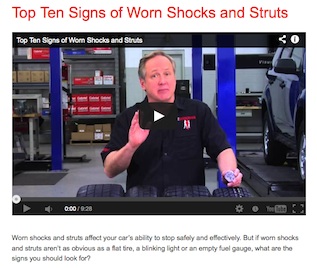TROY, Mich. — Gabriel (Ride Control, LLC), the originator of the world’s first automotive shock absorber in 1907, has introduced a new Answerman video to help communicate the indicators of worn shocks and struts on light vehicles. Gabriel’s new “Top 10 Signs of Worn Shocks and Struts” video is available to view at the Answerman section of Gabriel’s website or at YouTube on TheOriginalGabriel channel.
 “Often, drivers don’t know their shocks and struts have deteriorated, because wear happens gradually,” says Christine Fisher, marketing and communications manager at Gabriel. “The video supplies installers and counter-people with another means to communicate the signs of wear to consumers.”
“Often, drivers don’t know their shocks and struts have deteriorated, because wear happens gradually,” says Christine Fisher, marketing and communications manager at Gabriel. “The video supplies installers and counter-people with another means to communicate the signs of wear to consumers.”
Making it Easier to Spot the Signs of Worn Shocks and Struts
Every day, thousands of motorists may not even realize they are riding on significantly worn shocks and struts. In emergency maneuvers, these worn shocks and struts can lengthen braking distances and affect handling and stability. Gabriel’s 10 warning signs video helps to create clearer awareness of these signs with descriptions, video comparisons and actual product shots.
The 10 Gabriel signs that a vehicle might have of worn shocks and struts are:
1. When the vehicle has exceeded 50,000 miles on the current set
2. If the vehicle nose-dives while braking
3. If there is excessive bounce when driving over rough surfaces
4. When the vehicle veers in cross winds
5. If there is excessive lean or sway in turns
6. If the steering wheel vibrates
7. When uneven or premature tire wear is experienced
8. If fluid is leaking from the shock(s) or struts
9. If the shock or strut housing is dented or damaged
10. When your trained service technician raises concerns







